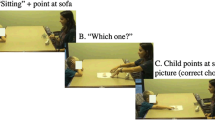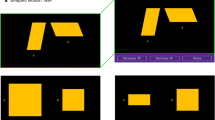Abstract
Sixteen autistic children with WISC Performance IQs of 70 or above were analyzed to determine their conceptions of spatial relations, size comparisons, and gesture imitations through the use of the WISC, an originally devised Language Decoding Test (LDT), and a modified Gesture Imitation Test (GIT). WISC results were replicated as in previous studies. The autistic children showed an inability to acquire concepts of size comparison and spatial relationships through verbal instructions. They often gave peculiar responses (partial imitations), which seem to be related to their inability to integrate another person's body as a whole through visual input. These findings support the notion that the basic cognitive deficit is an impairment of symbolic-representational functioning, including language and body images, which results from a combination of delay and deviation of the symbolic-representational function.
Similar content being viewed by others
References
Alpern, G. D. (1967). Measurement of “untestable” autistic children.Journal of Abnormal Psychology, 72, 478–486.
American Psychiatric Association. (1980).Diagnostic and statistical manual of mental disorders (3rd ed.). Washington, D.C.: American Psychiatric Association.
Bartak, L., & Rutter, M. (1976). Differences between mentally retarded and normally intelligent autistic children.Journal of Autism and Childhood Schizophrenia, 6, 109–120.
Bartak, L., Rutter, M., & Cox, A. (1975). A comparative study of infantile autism and specific developmental receptive language disorder: I. The children.British Journal of Psychiatry, 126, 127–145.
Bergès, J., & Lézine, I. (1965).The imitation of gesture. London: William Heinemann (Medical) Books.
Churchill, D. W. (1972). The relation of infantile autism and early childhood schizophrenia to developmental language disorders of childhood.Journal of Autism and Childhood Schizophrenia, 2, 182–197.
Churchill, D. W. (1978). Language: The problem beyond conditioning. In M. Rutter & E. Schopler (Eds.),Autism: A reappraisal of concepts and treatment. New York: Plenum.
Curcio, F. (1978). Sensorimotor functioning and communication in mute autistic children.Journal of Autism and Childhood Schizophrenia, 8, 281–292.
De Ajuriaguerra, J., & Stambak, M. (1969). Developmental dyspraxia and psychomotor disorders. In P. J. Vinken & G. W. Bruyn (Eds.),Handbook of clinical neurology (Vol. 4). Amsterdam: North-Holland.
DeMyer, M. K. (1975). The nature of the neuropsychological disability in autistic children.Journal of Autism and Childhood Schizophrenia, 5, 109–128.
DeMyer, M. K., Alpern, G. D., Barton, S., DeMyer, W. E., Churchill, D. W., Hingtgen, J. N., Bryson, C. Q., Pontius, W., & Kimberlin, C. (1972). Imitation in autistic, early schizophrenic, and nonpsychotic subnormal children.Journal of Autism and Childhood Schizophrenia, 2, 264–287.
DeMyer, M. K., Barton, S., Alpern, G. D., Kimberlin, C., Allen, J., Yang, E., & Steele, R. (1974). The measured intelligence of autistic children.Journal of Autism and Childhood Schizophrenia, 4, 42–60.
DeMyer, M. K., Barton, S., DeMyer, W. E., Norton, J. A., Allen, J., & Steele, R. (1973). Prognosis in autism: A follow-up study.Journal of Autism and Childhood Schizophrenia, 3, 199–246.
DeMyer, M. K., Hingtgen, J. N., & Jackson, R. K. (1981). Infantile autism reviewed: A decade of research.Schizophrenia Bulletin, 7, 388–451.
Ferrari, M. (1982). Childhood autism: Deficits of communication and symbolic development I. Distinction from language disorders.Journal of Communication Disorders, 15, 191–208.
Hermelin, B. (1978). Images and language. In M. Rutter & E. Schopler (Eds.),Autism: A reappraisal of concepts and treatment. New York: Plenum.
Hermelin, B., & O'Connor, N. (1970).Psychological experiments with autistic children. Oxford: Pergamon.
James, A. L., & Barry, R. J. (1981). General maturational lag as an essential correlate of early-onset psychosis.Journal of Autism and Childhood Schizophrenia, 11, 271–283.
Lockyer, L., & Rutter, M. (1970). A five to fifteen year follow-up study of infantile psychosis. III. Psychological aspects.British Journal of Psychiatry, 115, 865–882.
Lotter, V. (1978). Follow-up studies. In M. Rutter & E. Schopler (Eds.),Autism: A reappraisal of concepts and treatment, New York: Plenum.
Luria, A. R. (1970).Traumatic aphasia: Its syndromes, psychology and treatment. Paris: Morton.
Ricks, D. M., & Wing, L. (1975). Language, communication and the use of symbols.Journal of Autism and Childhood Schizophrenmia, 5, 191–221.
Rutter, M. (1968). Concepts of autism: A review of research.Journal of Child Psychology and Psychiatry, 9, 1–25.
Kutter, M. (1978a). Language disorder and infantile autism. In M. Rutter & E. Schopler (Eds.),Autism: A reappraisal of concepts and treatment. New York: Plenum.
Rutter, M. (1978b). Diagnosis and definition. In M. Rutter & E. Schopler (Eds.),Autism: A reappraisal of concepts and treatment. New York: Plenum.
Rutter, M. (1983). Cognitive deficits in the pathogenesis of autism.Journal of Child Psychology and Psychiatry, 24, 513–531.
Rutter, M., Greenfeld, D., & Lockyer, L. (1967). A five to fifteen year follow-up study of infantile psychosis. II. Social and behavioural outcome.British Journal of Psychiatry, 113, 1183–1199.
Rutter, M., & Lockyer, L. (1967). A five to fifteen year follow-up study of infantile psychosis. I. Description of sample.British Journal of Psychiatry, 113, 1169–1182.
Shah, A., & Frith, U. (1983). An islet of abnormality in autistic children: A research note.Journal of Child Psychology and Psychiatry, 24, 613–620.
Tymchuk, A. J., Simmons, J. A., & Neafsey, S. (1977). Intellectual characteristics of adolescent childhood psychotics with high verbal ability.Journal of Mental Deficiency Research, 21, 133–138.
Ungerer, J. A., & Sigman, M. (1981). Symbolic play and language comprehension in autistic children.Journal of the American Academy of Child Psychiatry, 2, 318–337.
Wassing, H. E. (1965). Cognitive functioning in early infantile autism: An examination of four cases by means of the Wechsler Intelligence Scale for Children.Acta Paedopsychiatrica, 32, 122–135.
Wing, L. (1969). The handicaps of autistic children-A comparative study.Journal of Child Psychology and Psychiatry, 10, 1–40.
World Health Organization. (1978).The ninth revision of the international classification of the diseases (ICD-9): Mental disorders. Geneva: Author.
Author information
Authors and Affiliations
Additional information
I would like to express my gratitude to my colleagues and the staff of the division of child psychiatry, and to Dr. Yoko Nagai, who performed the examinations of the second control group, as well as to the teachers and the parents of the kindergartens. I wish to thank Dr. Hiroshi Utena and Dr. Hiroyuki Kamiide for their supervision. This study was supported in part by a grant from the Ministry of Welfare.
Rights and permissions
About this article
Cite this article
Ohta, M. Cognitive disorders of infantile autism: A study employing the WISC, spatial relationship conceptualization, and Gesture Imitations. J Autism Dev Disord 17, 45–62 (1987). https://doi.org/10.1007/BF01487259
Issue Date:
DOI: https://doi.org/10.1007/BF01487259




